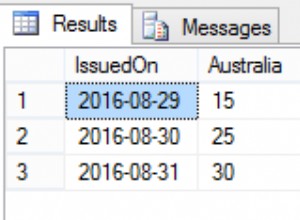Verwenden Sie benutzerdefiniertes Aggregat
Live-Test:http://sqlfiddle.com/#!17/16716/2
SELECT *, sum_with_reset(distance, 10) over (order by date asc) as running_distance
FROM tbl;
Benutzerdefinierte Summendefinition sum_with_reset:
create or replace function sum_reset_accum(
_accumulated numeric, _current numeric, _threshold numeric
)
returns numeric as
$$
select case when _accumulated >= _threshold then
_current
else
_current + _accumulated
end
$$ language sql;
create aggregate sum_with_reset(numeric, numeric)
(
sfunc = sum_reset_accum,
stype = numeric,
initcond = 0
);
Daten
CREATE TABLE tbl
("user_id" int, "date" timestamp, "distance" int)
;
INSERT INTO tbl
("user_id", "date", "distance")
VALUES
(1, '2019-04-09 00:00:00', 2),
(1, '2019-04-09 00:00:30', 5),
(1, '2019-04-09 00:01:00', 3),
(1, '2019-04-09 00:01:45', 7),
(1, '2019-04-09 00:02:30', 6),
(1, '2019-04-09 00:03:00', 1)
;
Ausgabe:
| user_id | date | distance | running_distance |
|---------|----------------------|----------|------------------|
| 1 | 2019-04-09T00:00:00Z | 2 | 2 |
| 1 | 2019-04-09T00:00:30Z | 5 | 7 |
| 1 | 2019-04-09T00:01:00Z | 3 | 10 |
| 1 | 2019-04-09T00:01:45Z | 7 | 7 |
| 1 | 2019-04-09T00:02:30Z | 6 | 13 |
| 1 | 2019-04-09T00:03:00Z | 1 | 1 |
Einzeiler:
create or replace function sum_reset_accum(
_accumulated numeric, _current numeric, _threshold numeric
)
returns numeric as
$$
select _current + _accumulated * (_accumulated < _threshold)::int
$$ language 'sql';
Der boolesche Postgres-Wert kann mit dem Cast-Operator ::int wahr auf 1 und falsch auf 0 umwandeln .
Sie können plpgsql verwenden Sprache auch:
create or replace function sum_reset_accum(
_accumulated numeric, _current numeric, _threshold numeric
)
returns numeric as
$$begin
return _current + _accumulated * (_accumulated < _threshold)::int;
end$$ language 'plpgsql';
Beachten Sie, dass Sie keine plpgsql-Funktion auf sqlfiddle.com erstellen können, also können Sie diesen plpgsql-Code nicht auf sqlfiddle.com testen. Du kannst es aber auf deinem Rechner.




